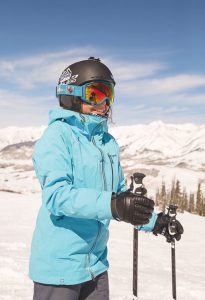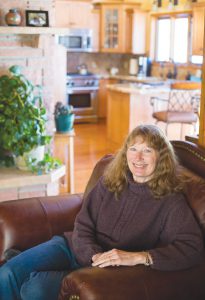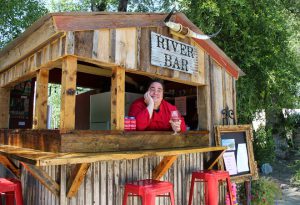“It’s not unusual to float your AMI around”
By Toni Todd
The Gunnison County Planning Commission, and what has become an especially large audience at meetings concerning The Corner at Brush Creek development proposal, heard presentations from the Gunnison Valley Regional Housing Authority (GVRHA) and Gatesco, Inc. last Friday. The morning was an opportunity to learn several possible approaches and strategies to the workforce housing challenge generally. It was also a time to hear what’s still being sorted out regarding how deed restrictions will work at the proposed project at Brush Creek Road and Highway 135 near Crested Butte.
GVRHA executive director Jennifer Kermode presented a slide show explaining three different workforce housing models, how deed restrictions work with both rentals and homes for purchase, and how Area Median Income (AMI) relates to rental rates. She called her presentation Workforce Housing 101.
The goal, said Kermode, is to create housing that costs no more than one third of a tenant’s gross income. That cost should include additional expenses associated with housing, such as utilities.
She listed forces at work in our community impacting the availability and affordability of housing in the Gunnison Valley: inadequate supply; low wages and a high cost of living; pressure from second homeowners/vacationers driving up costs; high construction and labor costs; loss of long-term rentals (due to proliferation of short-term rentals, or STRs); people retiring in place; and regulatory barriers.
“But we also want to preserve community character, open space, view corridors, and quality of experience to guests, find sustainable solutions and keep locals local,” Kermode said, implying a tall order in the face of formidable obstacles.
Kermode showed the gap between the need for housing and its availability in Gunnison County, as measured in the county’s 2016 Housing Needs Assessment. She noted 39 jobs posted in last week’s paper for the north valley and just five ads for rentals with the prices advertised. “Wages have not gone up from 2016 enough to make these rents affordable,” she said.
Ways to address the need
Three models of housing were presented as options to address housing needs in the valley.
Model 1, the Habitat for Humanity model, calls for prospective owners to help build their own homes, alongside contractors who provide guidance and who donate time and materials. Kermode said Habitat typically builds a home or two every couple of years.
Model 2, the community land trust model, involves public ownership of property designated for workforce housing. For example, “The community owns 40 acres or so,” Kermode suggested “and they build homes on that land. Buyers buy the house and lease the land under the house.”
Model 3 is the deed restriction model. Deed restriction controls who can rent or buy homes based on income and employment status, among other criteria, and also controls appreciation of the property in the event of a deed restriction that allows for home ownership.
“If someone makes 100 percent of AMI, does that mean they shouldn’t be a target of workforce housing?” asked Gunnison County community development director Cathie Pagano.
“The question is, if you’re making $55,000 a year, can you afford to buy a house in Crested Butte or Gunnison?” responded Kermode.
The AMI for one person in Gunnison County is $49,600. For a family of two, it’s $56,700 and for a family of four, $75,000. Kermode insisted it’s important to target a range of AMI. Workforce housing may be targeted at renters or owners up to 180 percent of AMI. Of course, it’s always more difficult, the lower a worker falls on the pay scale.
Kermode said some people feel that appreciation on deed-restricted homes for purchase should not be capped, but she disagrees. “I am of the mindset that if you are investing public dollars into a public asset, you need to stretch those dollars as far as possible. You want to make it a reasonable amount of appreciation for the current homeowner, but you also want to keep it affordable for the next owner.”
To qualify for deed-restricted housing, Kermode said, “People should be employed.”
Kermode suggested it’s also important to look at someone’s liquid assets, and whether deed restrictions might prohibit ownership of other properties.
“What happens when people want to retire in their deed-restricted property?” Kermode asked. “Do we force them to sell their home?” One idea is to allow someone who’s been part of the local workforce for many years to stay, but it’s also important to deter folks from moving into a deed-restricted unit and immediately retiring.
Rental concerns at Brush Creek
Referring to The Corner at Brush Creek proposal, commissioner Molly Mugglestone asked, “Is the housing authority involved as the deed restriction authority or is the county?”
“We’ve been working on establishing roles and responsibilities,” said Pagano. “That’s one of the things we might ask the housing authority to do.” The crafting of the deed restrictions in the case of The Corner at Brush Creek, Pagano added, will likely be a collaborative effort between the county and the GVRHA.
How do other resort towns
handle it?
Kermode described several workforce housing projects in other resort communities. Shandoka, in Telluride, has 134 apartments on 10.25 acres. It’s 100 percent income and employment restricted, with 12-month leases and a long waiting list.
Pinewood at Breckenridge is workforce townhomes for sale. Their first priority, said Kermode, was to sell to people who work within the town limits of Breckenridge. Once those units were sold, folks working outside the town limits but still in the county were included. “When you’re restricting by location of employment, you do it only at the time of purchase,” Kermode said. Pinewood also has a waiting list.
Buffalo Ridge at Avon/Eagle Vail was cited as the worst approach to resort-area workforce housing. Kermode described the complex as 176 units on 11.85 acres, separated by many miles from where these folks worked, and from basic town infrastructure, like shopping and schools. Most of the units—80 percent—are income restricted to 50 percent to 60 percent of AMI. Kermode described it as isolated and noisy. It’s located right off I-70 and overlooks the freeway, with no amenities nearby and no bus stop. “But it’s full,” Kermode said, “with a waiting list of 70.”
“This is an example of what not to do,” added Pagano.
“Has anybody figured it out and completely solved the housing challenge?” asked Kermode. “No. Places where people love to go, beautiful places, the pressures are still there and they continue.”
“We’ve heard from many that [The Corner at Brush Creek] is an attempt to solve the entire affordable housing problem,” added Pagano. “This is not the silver bullet that solves all of our problems, but this is one piece, and there are efforts going on in several places in addition to this.”
Pagano noted opportunities being explored at Larkspur and Buckhorn in Mt. Crested Butte, the Lazy K and Rock Creek in Gunnison.
“Communities are prioritizing based on what parcels are most ready for development,” said Kermode. Rock Creek in Gunnison, for example, is essentially ready to build, with utilities in place.
Kermode explained the difference between Brush Creek and Anthracite Place. Anthracite was built with tax credits that covered 70 percent of construction costs, she said, which made it possible to offer 100 percent of the units as deed-restricted and target a lower AMI.
“That’s not the case here,” Kermode said. An opportunity like Anthracite Place isn’t likely to come around again anytime soon. “There are only so many tax credits in the state of Colorado. They try to spread them out across the state,” Kermode said.
Making the numbers work
“There’s just no way for a developer to build a project in a high-cost place like this without some way to offset the cost of the affordable units,” said Kermode. That, she explained, is why 35 percent of the units at Brush Creek will be rented at market rate.
“The housing assessment is now a year old. How much progress have we made?” asked planning commissioner Jack Diani.
“We’re moving the needle now,” said Kermode. “It’s taking some time. The town of Crested Butte has taken some action.”
Working to alleviate regulatory barriers is another effort under way, added Kermode, along with finding ways to bank some land for future projects.
“The city of Gunnison has been working with a housing consultant out of Portland,” added Pagano. “He comes in and looks at zoning regulations and determines whether they make sense.”
Attorney Kendal Bergemeister spoke on behalf of Gatesco. He began by emphasizing the need, today and in the not-too-distant future. “Gunnison County is projected to have a population of 22,728 by 2050,” he said. “This isn’t just Crested Butte. This is a microcosm of a population boom statewide.”
The 2016 Housing Needs Assessment determined that the county needs 171 new, workforce housing units by 2020. “A couple of units a year is not going to get us to that 171 units,” said Bergemeister. “There’s a whole other need for for-sale units that’s not even addressed here. Look at what’s been proposed for Phase I of the project, compared to the demand in 2020. That’s 128 units as part of the 171. The proposal does not oversupply what is needed, either in aggregate, or at either of the various income levels.”
Bergemeister said Brush Creek would be available to tenants who qualify at various AMI:
—30 units at less than 80 percent
—64 units at less than 120 percent
—84 units at less than 180 percent
The idea, he said, is to provide some assurance that there could be units available to folks with low income, but also have some flexibility to accommodate a range of AMI.
Bergemeister explained that units would not be specifically designated for AMI ranges. Rather, any unit available could be rented to anyone within one of the ranges targeted, depending on need.
“There isn’t a specific physical space that’s designated to a specific AMI. Rather, as a renter grows, that unit grows into another AMI range,” said Bergemeister.
Who enforces the restrictions?
There was extensive discussion on how the deed restrictions would be managed and enforced if necessary.
“Having us manage it and submit a report is probably the best way to handle that,” responded Bergemeister. “We also thought that at the initial lease-up, maybe [the county] would play a more direct role, and then we handle it more on an ongoing basis. It’s a conversation we’re having.
“There’s been a misconception that we are going to charge everyone 30 percent of their income,” he added. “The 30 percent of household income is a cap. If you’re above 100 percent of AMI, that doesn’t mean much, because you can afford the market rate. So, the question related to those incomes isn’t the price; it’s the supply.”
“It’s not unusual to float your AMI around,” clarified Kermode.
Discussion evolved to the wide variety of housing needs in the valley. Planning commissioners wondered about the AMI of a pair of teachers to understand how this would apply to middle-income residents. They figured two teachers would land at 120 percent of AMI.
“If you make $50,000 a year, you’ll pay rent of $1,250, with utilities included,” said Bergemeister. “The current market rate for a two-bedroom unit on the open market is $1,250 to $2,400 per month.”
The shortage impacts a wider range of locals than one might imagine, said Kermode. “Dr. Tarr said they’re trying to recruit physicians [at the hospital] and they cannot find housing,” she said. “So, it ranges from service workers to professionals.”
Bergemeister said Gatesco is working on proposed lease terms. “We had initially proposed a minimum lease term of six months on a deed-restricted unit and a three-month lease on a market unit, to be sure to make it clear this is not a VRBO option. But we wanted to have some flexibility to accommodate seasonal workers,” Bergemeister said. “One concept we’re looking at now is deed-restricted units leased for one year, but maybe a small percentage of them could be leased at six months to a year. For free-market units, 80 to 90 percent would have to be six months or greater, but a small percentage could be leased out at three to six months.”
“Would that be in coordination with their employers?” asked Diani.
“Yes,” said Bergemeister. “If you’re going to have anything that’s less than a year, it’s got to be pursuant to an agreement with an employer.” Bergemeister suggested a master lease agreement with major employers to negotiate shorter leases, adding, “but someone who works with a smaller employer could get shut out of that option.”
“One of the difficulties for people moving into the area is the idea of first, last and security deposit,” said planning commissioner Vince Rogalski.
“Master lease agreements could be a way of addressing that, too,” said Bergemeister. “Perhaps they have some master security deposit that allows tenants to move in without that. That’s a detail we could certainly get into.”
December site visit scheduled
The next meeting to discuss The Corner at Brush Creek is scheduled for December 1. Planning commissioners will leave Gunnison at 10 a.m., arriving at the site about half an hour later, to conduct a second site visit, where they plan to walk the neighborhood and get an idea how the proposal might look, taking into account proposed building heights and other structural considerations. They’ll return to the commissioners’ meeting room at the Gunnison County Courthouse for a work session and further discussion at 1:30 p.m. that day.
 The Crested Butte News Serving the Gunnison Valley since 1999
The Crested Butte News Serving the Gunnison Valley since 1999




